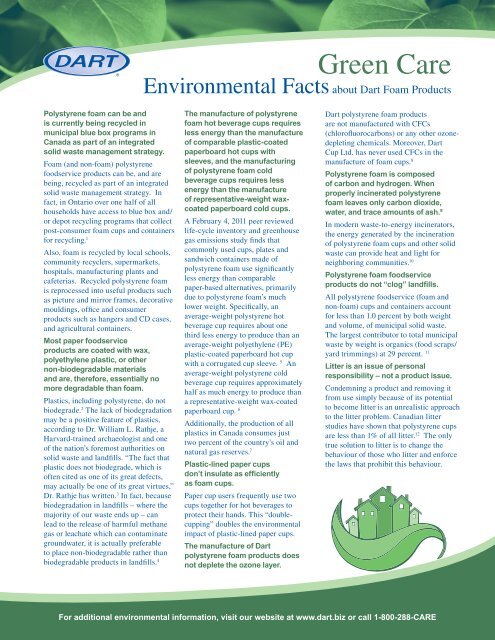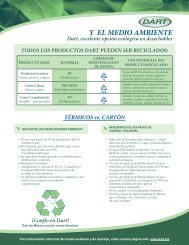Green Care
Green Care
Green Care
You also want an ePaper? Increase the reach of your titles
YUMPU automatically turns print PDFs into web optimized ePapers that Google loves.
Polystyrene foam can be and<br />
is currently being recycled in<br />
municipal blue box programs in<br />
Canada as part of an integrated<br />
solid waste management strategy.<br />
Foam (and non-foam) polystyrene<br />
foodservice products can be, and are<br />
being, recycled as part of an integrated<br />
solid waste management strategy. In<br />
fact, in Ontario over one half of all<br />
households have access to blue box and/<br />
or depot recycling programs that collect<br />
post-consumer foam cups and containers<br />
for recycling. 1<br />
Also, foam is recycled by local schools,<br />
community recyclers, supermarkets,<br />
hospitals, manufacturing plants and<br />
cafeterias. Recycled polystyrene foam<br />
is reprocessed into useful products such<br />
as picture and mirror frames, decorative<br />
mouldings, office and consumer<br />
products such as hangers and CD cases,<br />
and agricultural containers.<br />
Most paper foodservice<br />
products are coated with wax,<br />
polyethylene plastic, or other<br />
non-biodegradable materials<br />
and are, therefore, essentially no<br />
more degradable than foam.<br />
Plastics, including polystyrene, do not<br />
biodegrade. 2 The lack of biodegradation<br />
may be a positive feature of plastics,<br />
according to Dr. William L. Rathje, a<br />
Harvard-trained archaeologist and one<br />
of the nation’s foremost authorities on<br />
solid waste and landfills. “The fact that<br />
plastic does not biodegrade, which is<br />
often cited as one of its great defects,<br />
may actually be one of its great virtues,”<br />
Dr. Rathje has written. 3 In fact, because<br />
biodegradation in landfills – where the<br />
majority of our waste ends up – can<br />
lead to the release of harmful methane<br />
gas or leachate which can contaminate<br />
groundwater, it is actually preferable<br />
to place non-biodegradable rather than<br />
biodegradable products in landfills. 4<br />
Environmental Facts about Dart Foam Products<br />
The manufacture of polystyrene<br />
foam hot beverage cups requires<br />
less energy than the manufacture<br />
of comparable plastic-coated<br />
paperboard hot cups with<br />
sleeves, and the manufacturing<br />
of polystyrene foam cold<br />
beverage cups requires less<br />
energy than the manufacture<br />
of representative-weight waxcoated<br />
paperboard cold cups.<br />
A February 4, 2011 peer reviewed<br />
life-cycle inventory and greenhouse<br />
gas emissions study finds that<br />
commonly used cups, plates and<br />
sandwich containers made of<br />
polystyrene foam use significantly<br />
less energy than comparable<br />
paper-based alternatives, primarily<br />
due to polystyrene foam’s much<br />
lower weight. Specifically, an<br />
average-weight polystyrene hot<br />
beverage cup requires about one<br />
third less energy to produce than an<br />
average-weight polyethylene (PE)<br />
plastic-coated paperboard hot cup<br />
with a corrugated cup sleeve. 5 An<br />
average-weight polystyrene cold<br />
beverage cup requires approximately<br />
half as much energy to produce than<br />
a representative-weight wax-coated<br />
paperboard cup. 6<br />
Additionally, the production of all<br />
plastics in Canada consumes just<br />
two percent of the country’s oil and<br />
natural gas reserves. 7<br />
Plastic-lined paper cups<br />
don’t insulate as efficiently<br />
as foam cups.<br />
Paper cup users frequently use two<br />
cups together for hot beverages to<br />
protect their hands. This “doublecupping”<br />
doubles the environmental<br />
impact of plastic-lined paper cups.<br />
The manufacture of Dart<br />
polystyrene foam products does<br />
not deplete the ozone layer.<br />
<strong>Green</strong> <strong>Care</strong><br />
Dart polystyrene foam products<br />
are not manufactured with CFCs<br />
(chlorofluorocarbons) or any other ozonedepleting<br />
chemicals. Moreover, Dart<br />
Cup Ltd. has never used CFCs in the<br />
manufacture of foam cups. 8<br />
Polystyrene foam is composed<br />
of carbon and hydrogen. When<br />
properly incinerated polystyrene<br />
foam leaves only carbon dioxide,<br />
water, and trace amounts of ash. 9<br />
In modern waste-to-energy incinerators,<br />
the energy generated by the incineration<br />
of polystyrene foam cups and other solid<br />
waste can provide heat and light for<br />
neighboring communities. 10<br />
Polystyrene foam foodservice<br />
products do not “clog” landfills.<br />
All polystyrene foodservice (foam and<br />
non-foam) cups and containers account<br />
for less than 1.0 percent by both weight<br />
and volume, of municipal solid waste.<br />
The largest contributor to total municipal<br />
waste by weight is organics (food scraps/<br />
yard trimmings) at 29 percent. 11<br />
Litter is an issue of personal<br />
responsibility – not a product issue.<br />
Condemning a product and removing it<br />
from use simply because of its potential<br />
to become litter is an unrealistic approach<br />
to the litter problem. Canadian litter<br />
studies have shown that polystyrene cups<br />
are less than 1% of all litter. 12 The only<br />
true solution to litter is to change the<br />
behaviour of those who litter and enforce<br />
the laws that prohibit this behaviour.<br />
For additional environmental information, visit our website at www.dart.biz or call 1-800-288-CARE
Notes<br />
1 2010 data on Waste Diversion Ontario’s Datacall website http://www.wdo.ca/<br />
content/?path=page82+item37561 and Statistics Canada: http://www.statcan.ca/menu-en.htm.<br />
2 The Polystyrene Packaging Council, Polystyrene and Its Raw Material, Styrene: Manufacture and Use,<br />
November 1993, p. 1.<br />
3 William L. Rathje, “Rubbish!” The Atlantic Monthly, December 1989, p. 103.<br />
4 William Rathje and Cullen Murphy, “Five Major Myths About Garbage, and Why They’re Wrong,”<br />
Smithsonian, July 1992, p. 5.<br />
5 Franklin Associates, a Division of ERG, Life Cycle Inventory of Foam Polystyrene, Paper-Based, and PLA<br />
Foodservice Products, February 2011, Table 2-2 Total Column. See also: Franklin Associates, Ltd., Final<br />
Peer-Reviewed Report: Life Cycle Inventory of Polystyrene Foam, Bleached Paperboard, and Corrugated<br />
Paperboard Foodservice Products (Prepared for The Polystyrene Packaging Council, March 2006), Table 2-2,<br />
p. 2-7.<br />
6 Ibid, Table 2-3 Total Column. See also: Ibid, Table 2-3, p. 2-8.<br />
7 Canadian Plastics Industry Association statistics, 2004.<br />
8 Those foodservice manufacturers of polystyrene foam that employed CFCs in their manufacturing processes<br />
ceased using them by 1990. Judd H. Alexander, In Defense of Garbage (Westport, CT: Praeger Publishers,<br />
1993), p. 55.<br />
9 The Polystyrene Packaging Council, Polystyrene and Its Raw Material, Styrene: Manufacture and Use,<br />
November 1993, p. 27–28.<br />
10 In past years, waste-to-energy has been viewed negatively by persons concerned about the environmental<br />
effects of incinerations. As technology has improved, however, modern incinerators have become a safe and<br />
effective method of handling many post-consumer materials. According to Franklin Associates, Ltd., a leading<br />
solid waste consulting firm, “At some point after 2000, the use of finite resources, e.g. fossil fuels, may lead<br />
to a more welcoming climate for expansion of waste-to-energy as an alternative solid waste management<br />
technique.” Franklin Association, Ltd., Solid Waste Management at the Crossroads, December 1997, p. 1-24.<br />
11 William Rathje and Cullen Murphy, “Five Major Myths About Garbage, and Why They’re Wrong,”<br />
Smithsonian, July 1992, p. 5. See also: Franklin Associates, Ltd., Waste Management and Reduction Trends<br />
in the Polystyrene Industry, 1974–1994, June 1996, Updated August 1999; and United States Environmental<br />
Protection Agency, Municipal Solid Waste in the United States 2010 Facts and Figures, November 2011,<br />
Table 3.<br />
12 MGM Management prepared for The City of Toronto Works and Emergency Service, Solid Waste<br />
Management Services Division, Toronto Litter Survey 2002, September 2002, p. 27.<br />
M-9301 rev. 1/2012 ©2012 Dart Container Corporation



